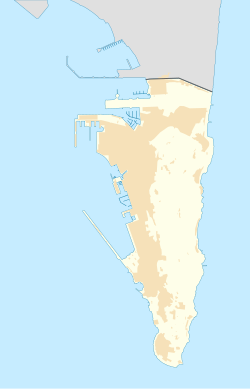| Vanguard Cave | |
|---|---|
 | |
Map showing location of Vanguard Cave in Gibraltar. | |
| Location | Below the eastern side of the Rock of Gibraltar |
| Coordinates | 36°07′17.5″N05°20′31″W / 36.121528°N 5.34194°W |
| Depth | 17 metres (56 ft) |
| Height variation | 35 metres (115 ft) |
| Geology | Limestone |
Vanguard Cave is a natural sea cave in the British Overseas Territory of Gibraltar which is part of the Gorham's Cave complex. This complex of four caves has been nominated as a UNESCO World Heritage Site status in 2016. The cave complex is one of the last known habitations of the Neanderthals, with a period of inhabitation from 55,000 to 28,000 years ago. [1] It is located on the southeast face of the Rock of Gibraltar.

